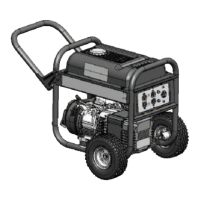5
GENERATOR CAPACITY
Make sure the generator can supply enough continuous
(running) and surge (starting) watts for the items you will
power at the same time. Follow these simple steps.
1. Selecttheitemsyouwillpoweratthesametime.
2. Totalthe continuous(running)watts oftheseitems. Thisis
the amount of power the generator must produce to keep the
items running. See the wattage reference chart at right.
3. Estimate how many surge (starting) watts you will need.
Surge wattage is the short burst of power needed to start
electric motor-driven tools or appliances such as a circular
saw or refrigerator. Because not all motors start at the same
time, total surge watts can be estimated by adding only the
item(s) with the highest additional surge watts to the total
rated watts from step 2.
Example:
Tool or Appliance
Continuous
(Running) Watts
Surge
(Starting) Watts
Window AC,
10,000 BTU
1200 1800
Refrigerator 700 2200
1/3 HP Well Pump 1000 2000
27 in. Television 500 0
Light (75 Watts) 75 0
3475 Total
Running Watts
2200 Highest
Surge Watts
Total Continuous (Running) Watts 3475
Plus Highest Additional Surge Watts + 2200
Equals Total Generator Output Required 5675
POWER MANAGEMENT
To prolong the life of the generator and attached devices,
it is important to take care when adding electrical loads to
the generator. There should be nothing connected to the
generator outlets before starting its engine. The correct
and safe way to manage generator power is to sequentially
add loads as follows:
1. With nothing connected to the generator, start the engine as
described later in this manual.
2. Plug in and turn on the first load, preferably the largest load
you have.
3. Permit the generator output to stabilize (engine runs smoothly
and attached device operates properly).
4. Plug in and turn on the next load.
5. Again, permit the generator to stabilize.
6. Repeat steps 4 and 5 for each additional load.
Never add more loads than the generator capacity. Take
special care to consider surge loads in generator capacity
as previously described.
Tool or Appliance
Typical
Continuous*
(Running)
Watts
Typical
Surge
(Starting)
Watts
Essentials
LightBulb−75Watt
75 75
Refrigerator/Freezer 700 2200
SumpPump−1/2HP
1050 2200
WaterWellPump−1/3HP
1000 1500
Electric Water Heater 4000 0
Heating/Cooling
FurnaceFan−1/2HP
800 2350
WindowAC−10,000BTU
1200 1800
Space Heater 1800 0
Kitchen
MicrowaveOven−1000Watt
1000 0
Coffee Maker 1000 0
ElectricStove−SingleElement
2100 0
Toaster Oven 1200 0
Family Room
VCR 100 0
CD/DVD Player 100 0
Stereo Receiver 450 0
ColorTelevision−27in.
500 0
Other
Security System 500 0
Curling Iron 1500 0
GarageDoorOpener−1/2HP
875 2350
HairDryer−1/2HP
1250 0
DIY/Job Site
Quartz Halogen Work Light 1000 0
AirlessSprayer−1/3HP
600 1200
Reciprocating Saw 960 0
ElectricDrill−1/2HP
600 900
CircularSaw−7-1/4in.
1400 2300
MiterSaw−10in.
1800 1800
Planer/Jointer−6in.
1800 1800
TableSaw/RadialArmSaw−
10 in.
2000 2000
AirCompressor−1HP
1600 4500
*Wattages listed are approximate. Check tool or appliance for actual watt-
age.
ELECTRICAL
CAUTION:
Do not overload the generator’s capacity. Exceeding the
generator’s wattage/amperage capacity can damage the
generator and/or electrical devices connected to it.

